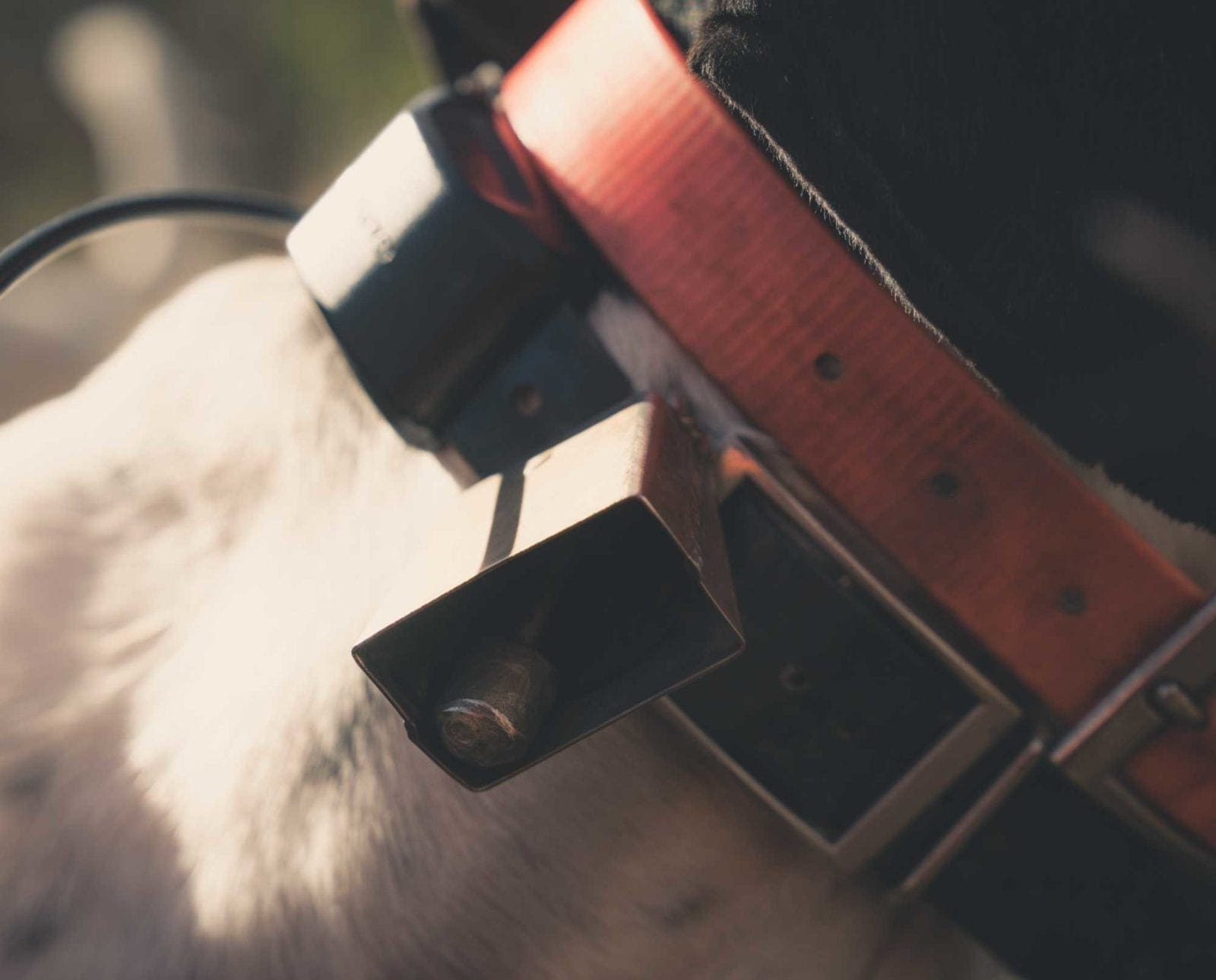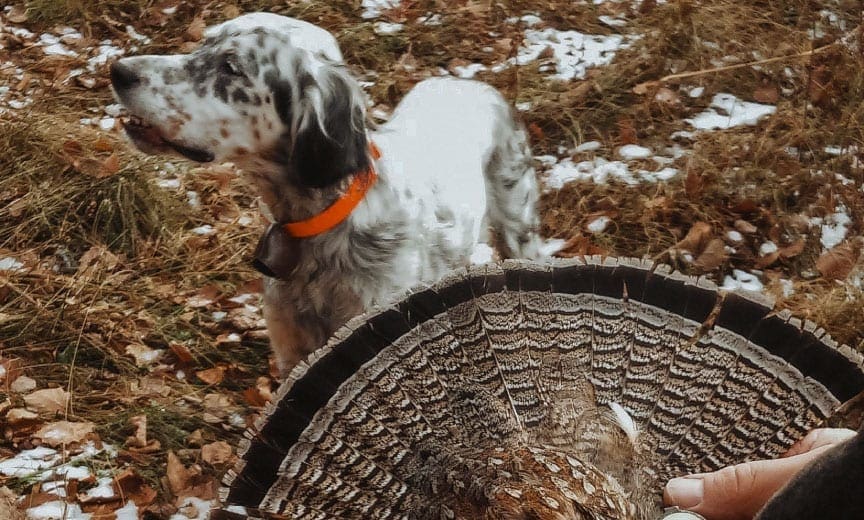Home » Hunting Culture » Should New Technology Have a Place in Upland Bird Hunting?
Should New Technology Have a Place in Upland Bird Hunting?

Mark Parman lives in Seeley, Wisconsin, with his wife, Susan,…
The author muses on the idea of blending old technology with the new as the culture of upland hunting pushes into the future.
“Turn left up here at the next intersection,” Mike said peering at the GIS map of northwestern North Dakota on his phone. The turn was just over the next rise, and when we started east, he said, “It’s another mile and a half.” Up on the next rise, we could see miles of prairie rolling east as cottony clouds billowed down out of Canada. Between the clouds, a deep blue. It was late September, and we were sharp-tailed grouse hunting, searching for public land with just the right mix of cover for those birds.
When we got to the section of land listed as public on Mike’s map, I pulled the truck over and studied the section of prairie. “What do you think?” Mike asked.
“Thin to win,” I answered. It appeared to have the right mix of short grass and buffalo berries on a series of ridges that culminated in a high ridge. It sure looked birdy.
“Let’s do it,” he said, and so I pulled the truck onto the grassy shoulder, we unloaded the dogs and began to hunt. An hour later, I was back at the truck with two sharpies while Mike was still off hunting the western side of the section. I’d heard three of four shots in the distance. While waiting for him, I grabbed my phone from out of the truck and texted a picture of Jenkins, my setter, posing with the two sharpies and wrote: “Old guy can play this game too. You got three?”
We were a few days into a weeklong sharptail hunt in North Dakota when it struck me that I was 20-25 years older than the rest of the group. As the old coot in the group, the one from the rotary dial phone age, I was surprised at their use of cell phones in the field — not just for digital maps, but also for keeping in contact and using social media. It was routine for them to send pictures out onto the internet in the middle of a hunt. This was new to me as I started hunting in the mid 70s, a time when licenses were a simple piece of paper sold over the counter at Zip’s Hardware, where I could also buy shotshells by the handful. I could typically afford five 10 Remington Express shells with my paper route money, and felt rich if I could afford 10. It was a different time — no GIS maps, no GPS, no e-collars, no cell phones, no trail cameras, no precision optics, all of the technology we’ve come to think of as indispensable to modern hunting. It’s easy for me to rhapsodize about the good old days, but some of the new technology has its place. What place is what we need to ask ourselves.
Even before I started hunting, Aldo Leopold had addressed the question of appropriate technology for hunters. He wrote in A Sand County Almanac about sportsmanship being the “voluntary limitation” in the use of technology and that it’s “aimed to augment the role of skill and shrink the role of gadgets in the pursuit of wild things.” Leopold went on to write that hunters don’t have “a gallery to applaud or disapprove of (our) conduct. Whatever (our) acts, they are dictated by (our) conscience, rather than a mob of onlookers. It is difficult to exaggerate the importance of this fact.” The Wisconsin conservationist, however, did admit he didn’t know the answer to his question. “I do not pretend to know what is moderation, or where the line is between legitimate and illegitimate gadgets.” He believed, as I do, that we all, with fear and trembling, must answer that question and choose wisely.
For instance, what type of shotgun do we shoot in the uplands? If we were all Luddites, we’d shoot blackpowder flintlocks loaded with birdshot or perhaps a newfangled breech-loading singleshot. I shot my first grouse with a Stevens Model 94 singleshot 12-gauge, but after that first intoxicatingly addictive flush, I immediately starting saving my dollars for a more effective gun, which ended up being a heavily used over-and-under.
Recently, I grouse hunted with a friend who usually totes a sleek 20-gauge over-and-under, but this day he pulled out an autoloading 12-gauge and jacked one shell in the breech and pushed another four in the magazine. I shot him a questioning glance, which made him smile. Twice he fired three shots at birds, one within range and one too far out of it. Neither bird was hit. Sometimes game laws step in, limiting our technology, and we aren’t given a choice, which simplifies life. For example, North Dakota has a three-shot magazine restriction, like federal waterfowl regulations, for small game hunting.
Weapon choice raises other questions. Gauge? Screw-in chokes? Spreader loads? What’s fair? A few days after the hunt with my friend, I was grouse hunting and walking a trail with my wife, Susan, when she picked up a spent shell casing. “What’s this, a pencil?” she asked. It was a .410 casing, only the second I’d seen in my 30 years in the grouse woods. I wondered if whoever fired it thought the rest of us using 28s, 20s, 16s or 12s were a bunch of hacks using way too much firepower for ruffed grouse and American woodcock.
We make all kinds of technological decisions when we hunt, and the opinions behind those decisions are often strong. Take dog collars, for example. We can buy e-collars, beeper collars, bark collars, GPS collars, as well as combinations of these gadgets. For ourselves, we can purchase a GPS unit or a compass, which is a whole other navigational matter. The e-collar is also a separate debate entirely, and there’s not room to address it here. In short, there’s no doubt it has ruined many gun dogs, and in the wrong hands it’s torture, but others see it as a godsend and wonder what we ever did without it. Just like the cell phone or the computer.

I don’t use a beeper collar on my English Setters. Instead, I run them with a bell. On a sharptail hunt, neither bell nor beeper seemed necessary, but in the thick and sometimes claustrophobic grouse woods, you need something to keep track of the dog. With just a bell, I occasionally lose track of my dog, like I did the other day on a warm and windy afternoon. Jenkins ran over a ridge, taking his bell out of earshot. I waited a minute or so and he didn’t come around, so I trudged up the ridge, stood still, and listened. Silence. I started down the ridge top and found him a few minutes later, still on point. I took a few steps towards him, and a grouse rocketed up and away, more sound than image, leaving me stunned and without a shot. After taking so long to find Jenkins, I figured the bird was long gone. Chalk one up for the ruffed grouse. A beeper collar would have allowed me to locate him quicker, although I doubt I would have had a clearer shot. Even though I lose a handful of chances every season, I stick with the simplicity of the bell, a small price for me to pay and a gift to those grouse that get away.
If my dogs ran bigger, I would seriously consider getting a beeper collar or a GPS collar. Obviously a pointing dog covering more ground gets exponentially more difficult to find, especially when the leaves are still on the trees and brush. Plus, such a device would be much more reassuring, perhaps falsely, in wolf country. We can have the best of both the old and new technology too if we want, fitting a bell to the GPS collar. With a GPS collar, you also can see just how much ground your dog covered at what speed. You can see what part of the cover your dog hunted and what it missed. This can be overwhelming to some, but others crave such information.
For me, technological choices revolve around fair chase, actually, what we individually consider fair chase, for we all must answer it every time we step into the fields and woods. Our view toward technology may change over time as well. As an older hunter, I’m no longer driven to put as many grouse and woodcock as possible in my game bag and, consequently, my take on what I consider appropriate has evolved. My shotguns have gotten lighter and smaller in gauge, but as I further slow, in the future I may need to consider GPS to keep them in contact.
The mix of technology surprised me on our sharptail hunt. It was a pleasant and effective mix of old and new. Three in the group shot vintage side-by-sides, guns pushing 100 years of use. Their balance, grace and craftsmanship was evident, even after a century in the field. In my eyes, these old shotguns make black or camo guns look crude, ugly, and menacing. There was also a nice mix of wool and waxed canvas, garments that have been protecting and keeping hunters warm for a century as well, and there was a sprinkling of L.L. Bean gum boots and knee high rubber boots, also old but still useful technology.
On the other hand, I don’t know where we would have been (literally) without satellite mapping. And without social media, much sharing and joy would have been lost. Which is a lot to say, coming from an old guy who likes USGS paper maps, not to mention magazines and books.
Mark Parman lives in Seeley, Wisconsin, with his wife, Susan, and setters, Fergus and Jenkins. He has written two books about ruffed grouse hunting: Among the Aspen and A Grouse Hunter's Almanac. He still enjoys a good paper map.





As long as technology represents safety go for it. Just with phones and GPS we have multiple options to have constant contact with our dogs, our families, emergency services and our hunting partners. It only takes one time for the technology to turn the tide of a tragic event to make it all worth while.
Any other debate is left for a beer and campfire after a long day following a dog.
The fair chase argument does not hold water for me. It has nothing to do with management. Hunting techniques should be based on personal choice and be informed by safety, humane methods of killing, and proper management.
Well written, Mark. Thank you.
Thanks, Rick, for the comments. Since I wrote this, I’ve gotten a Paint River Llewellin who runs pretty big in the woods. I have a beeper for him, but he’s not fan of that technology, so I’ve been losing him occasionally when he points. Keeps things exciting.
Mr. Parman, very well written and thoughtful. I am currently reading “A grouse hunter’s almanac” for the umpteenth time and also have “Among the aspen” in my library. Both books are some of my favorites.